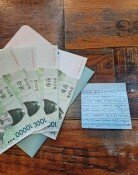15th century scroll provides peek into Joseon-era signatures
15th century scroll provides peek into Joseon-era signatures
Posted April. 09, 2015 07:21,

On November 14, 1456, King Sejo, the seventh king of the Joseon Dynasty, held a meeting of meritorious retainers who contributed to his rise to the throne and their offspring to mark the second anniversary of his accession. At the gathering of 226 people, the attendees shared blood in a copper container as a token of their pledge of allegiance to the king. Dead contributors were represented by their oldest legitimate sons.
The king created a letter of an 8-meter-long scroll with letters of loyalty on which 157 people, including his crown prince, royal family members and meritorious retainers signed. Therefore, the letter is considered a "treasure box" by scholars who study Joseon-era signatures.
The Jangseogak Archives of the state-funded Academy of Korean Studies said Wednesday that the descendants of Yi Bo-saeng, a member of Joseon`s royal family, had recently donated the scroll to the organization.
The scroll shows that the signatures at that time were mostly written in broken-down Chinese characters. For example, Prince Yangnyeong broke down the Chinese character for his name "Je (褆)" into "衣" and "是." Prince Hyoryeong also split his name Bo (補) into "衣" and "甫."
It is also interesting that the scroll does not have the signature of Han Myung-hoe, one of King Sejo`s closest confidants, suggesting that he was too powerful to be under such pressure from others, including even the king.
Kim Hak-soo, a senior researcher at the Academy of Korean Studies, said that King Sejo, who came to power by forcing his powerless predecessor and young nephew Danjong, to abdicate, had a sense of crisis that compelled him to defense his reign by uniting his royal forces whom he could trust and had them sign the letter of allegiance.
sukim@donga.com







